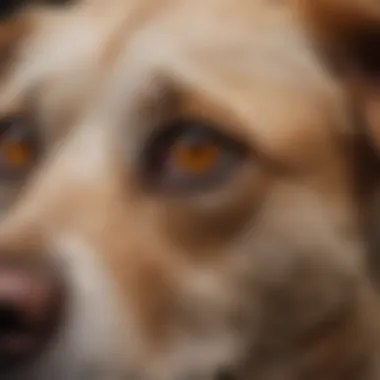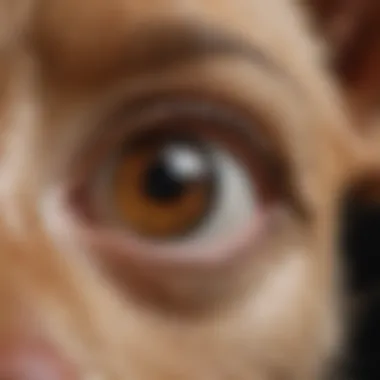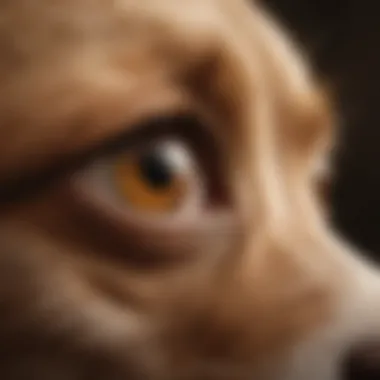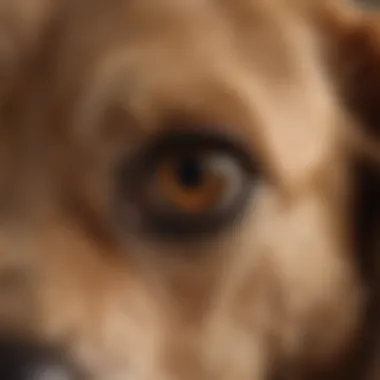Effective Strategies to Eliminate Brown Eye Stains in Dogs


Intro
Understanding brown eye stains in dogs is crucial for pet owners. These stains, often a result of tear production, can affect a dog's appearance and overall health. Recognizing the causes and implementing proper cleaning techniques can significantly improve a dog’s hygiene.
This guide delves into the factors contributing to brown eye stains and outlines various methods for removal. By addressing these issues, dog owners can maintain their pet's health and enhance their quality of life.
Animal Profile
General Overview
Dogs are domesticated mammals and come in various breeds, each with unique characteristics. Some breeds, especially those with prominent eyes, are more prone to tear staining. For example, breeds like Maltese, Poodles, and Shih Tzus often display brown eye stains.
Habitat and Distribution
Dogs are found worldwide, living in diverse environments. Their adaptability has led to their presence in urban, suburban, and rural settings. While they thrive alongside humans, their health can be influenced by their living conditions, which may contribute to tear stains if not monitored.
Important Factors
Brown eye stains can arise from several factors, including:
- Diet: Poor nutrition can lead to excessive tear production.
- Genetics: Breed predispositions can increase staining.
- Environmental Irritants: Allergens may provoke tearing.
By identifying and understanding these elements, owners can take action to mitigate the stains effectively.
Care Tips for Pet Owners
Basic Needs and Requirements
Proper care begins with meeting a dog's basic needs:
- A balanced diet rich in vitamins and minerals.
- Regular exercise to maintain a healthy weight and overall wellbeing.
- Routine grooming to keep their fur clean and free from debris.
Health and Wellness Tips
Maintaining eye health is important:
- Regular Vet Visits: Consult your veterinarian for eye check-ups.
- Grooming: Keep facial hair trimmed to minimize tear interference.
- Cleaning Techniques: Use a gentle, approved cleaner to address stains.
Keeping a proactive approach to eye care can prevent further health issues in your dog.
Finale
Understanding Brown Eye Stains in Dogs
Brown eye stains in dogs represent a common concern among pet owners. Understanding the underlying causes can significantly benefit the health and hygiene of your dog. These stains can create not just aesthetic issues, but also indicate potential health problems. Ignoring these signs can lead to infections or worsening conditions. Identifying the factors behind these stains helps owners respond appropriately, ensuring that their pets remain healthy and comfortable.
What Causes Brown Eye Stains?
Genetic predisposition
Genetic predisposition plays a significant role in the formation of brown eye stains. Certain breeds are more prone to staining due to inherited traits. These breeds may produce more tears or have anatomical issues that allow for staining. The acknowledgment of genetic predisposition allows pet owners to anticipate potential issues early. Understanding that some dogs are more likely to have this condition can prepare owners for appropriate care.


Dietary factors
Dietary factors greatly influence brown eye stains in dogs. A diet high in certain ingredients can increase tear production, leading to staining. Identifying which foods contribute to this condition is essential. The presence of artificial colors and preservatives in dog food can be a key element. Choosing a high-quality diet that promotes overall health is advisable. Owners need to monitor their dog’s diet closely to mitigate this problem effectively.
Environmental irritants
Environmental irritants are another key factor contributing to brown eye stains. Dust, pollen, and chemicals can trigger excessive tearing, which in turn causes staining beneath the eyes. Recognizing these irritants allows pet owners to make adjustments in their dogs’ environments. Implementing simple changes, such as frequent cleaning and reducing exposure to irritants, can improve the situation. Monitoring environmental factors is crucial for reducing the frequency of brown stains.
Common Breeds Affected
Small breed tendencies
Small breeds frequently exhibit brown eye stains due to their unique facial structures. Brachycephalic (short-faced) breeds often suffer from tear duct abnormalities. These can lead to excessive tearing, causing discoloration around the eyes. Understanding this tendency can help owners select grooming practices that cater to their pet’s needs. Recognizing that small breeds are predisposed can guide owners in implementing preventive measures.
Short-nosed breed issues
Short-nosed breeds, like Bulldogs and Pugs, are particularly prone to eye stains. Their facial structure may put pressure on tear ducts, leading to tear overflow. Such anatomical traits lead to constant moisture around the eyes, fostering brown staining. Acknowledging these issues helps in developing specific care routines. Short-nosed breeds require tailored attention to their unique challenges concerning eye health.
Long-haired breed considerations
Long-haired breeds, such as Shih Tzus and Maltese, often face eye staining as well. Their fur can trap moisture and exacerbate staining effects. Grooming becomes paramount for these breeds to mitigate staining. Regularly trimming fur around the eyes can significantly help in keeping the area clean. Awareness of these grooming needs ensures that long-haired breeds can maintain a healthier appearance.
Health Implications
Infection risks
Infection risks are a major concern when it comes to brown eye stains. When moisture accumulates, it creates an ideal environment for bacteria. This scenario can result in conjunctivitis or other eye infections. Recognizing the link between staining and potential infections is vital. Early intervention and proper cleaning can help prevent serious health issues.
Allergy connections
Allergy connections might also contribute to the problem. Dogs suffering from allergies may experience increased tearing that results in staining. It's important for pet owners to identify and manage allergies to alleviate excessive tearing. Understanding how allergies tie into eye health allows for more effective treatment plans. Addressing these allergies can ultimately lead to a better quality of life for affected dogs.
Dental health correlation
Dental health is closely linked to eye staining, often overlooked. Poor dental hygiene can lead to bacteria entering the bloodstream, potentially resulting in eye issues. Regular veterinary check-ups focusing on both dental and eye health can help prevent these concerns. Adopting preventive measures can foster overall well-being for dogs. Maintaining dental health is crucial to preventing cascading effects on eye health and staining.
Identifying Brown Eye Stains
Identifying brown eye stains is a crucial step in addressing this condition in dogs. Early recognition aids in understanding the underlying causes and can facilitate timely intervention. Proper identification allows pet owners to differentiate between regular tear staining and more serious issues that might need veterinary attention. This section focuses on the visual symptoms associated with brown eye stains and provides guidance on when to seek veterinary advice.
Visual Symptoms to Look For
Color variations
Color variations in the staining can range from light brown to dark reddish-brown. This particular detail is important as it can indicate different causes for the staining. Notably, lighter colors may suggest less severe staining, while darker tones might indicate more prolonged exposure to irritants or other underlying issues. Identifying these color changes can help in assessing the dog's condition. A distinct characteristic of this aspect is that it offers visible clues to the type of care needed. Observing these variations can alert pet owners on how to proceed further.
Texture differences
Texture differences in the stained area can provide insights into the duration and nature of the staining. A smooth texture may indicate the stains are relatively fresh, while rougher or crusty textures might suggest long-standing issues. Pet owners should closely examine these areas for changes over time. This feature plays a vital role in determining appropriate cleaning techniques. Identifying texture changes can help in evaluating the need for professional cleaning or veterinary intervention.
Associated discharge


Associated discharge can often accompany brown eye stains, signifying potential infections or irritations. This aspect is critical as it can change the approach to treatment. Owners are advised to take special note if the discharge is excessive or has an unusual color. The presence of discharge often denotes a need for more urgent veterinary consultation. Recognizing this unique characteristic helps determine if the stains are merely cosmetic or indicative of a deeper health concern.
When to Seek Veterinary Advice
Persistent staining
Persistent staining is a signal that should not be overlooked. If brown stains continue despite regular cleaning efforts, this could indicate an underlying problem. Such situations highlight the importance of identifying persistent staining as it may require a veterinary evaluation. This characteristic indicates that home remedies may not be sufficient to resolve the issue, warranting further investigation.
Signs of infection
Signs of infection can manifest as increased redness, swelling, or a change in the discharge from the eyes. Recognizing these indicators plays a key role in maintaining a dog's health. Understanding these signs can lead to earlier intervention, which is vital for preventing more severe complications. Identifying signs of infection is thus essential in determining the need for veterinary care.
Overall health concerns
Overall health concerns can encompass various conditions, including allergies or dental issues, which may influence the appearance of brown eye stains. Being aware of such implications is crucial for dog owners. This knowledge allows pet owners to connect the dots between the staining and broader health issues potentially affecting their dogs. Recognizing overall health concerns encourages a proactive approach to care, emphasizing the importance of veterinary guidance when necessary.
Cleaning Techniques for Eye Stains
Cleaning techniques for eye stains are crucial for maintaining a dog’s health and appearance. These stains can be unsightly and may result from various factors, including genetics and environmental irritants. Regular cleaning not only helps to improve the aesthetic of a dog but also plays a part in preventing more serious health issues.
Daily Cleaning Regimen
Recommended cleaning solutions
Using the right cleaning solutions is vital for effective stain management. There are several options available, from commercial products to natural alternatives. One popular choice is a saline solution, which is gentle and effective. Saline solutions help to remove stains without causing irritation to sensitive areas around the eyes. They are often favored because they do not contain harsh chemicals that can lead to potential irritation.
Proper application techniques
Applying cleaning solutions correctly is essential. The key is to use a soft cloth or cotton ball to gently wipe the affected area. A patting motion is recommended over rubbing. Too much pressure can cause discomfort or even injury. By using the correct technique, owners can ensure effective cleaning without harming the skin or surrounding tissues. It promotes an overall positive experience for the dog during cleaning sessions.
Frequency of cleaning
How often one cleans their dog’s eyes plays a significant role in managing stains. Generally, a daily cleaning routine is advisable. This regularity prevents the build-up of tears and bacteria that contribute to discoloration. Keeping to a consistent schedule helps to reduce the severity of stains over time. However, frequency may vary depending on the specific breed and existing conditions.
Home Remedies
Natural cleaning agents
Natural cleaning agents can be effective and safe choices for eye stain removal. Options like pure coconut oil or apple cider vinegar diluted with water have been noted for their cleaning properties. Coconut oil has moisturizing benefits, which can soothe the skin around the eyes. However, it's important to ensure that any agent used does not irritate the dog's eyes further or lead to discomfort.
Homemade solutions
Preparing homemade solutions is another avenue for dog owners to explore. A simple mixture of water and baking soda can be an efficient cleaning agent. It’s important to ensure all ingredients used are safe for pets. Homemade solutions can offer a personalized touch, aligning with owners’ preferences. Nevertheless, due caution is necessary to avoid potential adverse reactions.
Assessing effectiveness
Evaluating how well cleaning methods work is key. Pet owners should monitor changes in eye stains over time. If the stains persist or worsen, it may signal a more serious issue that may require veterinary attention. Also, it is essential to observe the dog for any signs of irritation or discomfort following the application of any remedy. A careful assessment will guide further decisions on cleaning practices.
Professional Grooming Options
Groomer recommendations


Consulting with professional groomers can provide valuable insights into effective cleaning methods. Groomers are often well-informed about the latest products and techniques. They can recommend specific products tailored to a dog’s breed and condition. Using a professional’s experiences can ensure the adoption of best practices in managing eye stains.
Understanding the process
Understanding the grooming process is crucial for dog owners. Typically, professionals may use special solutions specifically designed to tackle tough stains. Learning about the techniques they employ can empower owners to replicate effective strategies at home. Discussions with groomers can also clarify what products are safe or best suited for individual dogs.
Maintaining results post-grooming
After seeking professional grooming, maintaining results is key. It is advisable to continue with a regular cleaning regimen to prevent the return of stains. This consistent approach will help to ensure that the effects of professional grooming last longer. Setting a routine contributes to the long-term health of the dog's eyes and minimizes future grooming needs.
Preventative Measures
Preventative measures play a crucial role in managing brown eye stains on dogs. By adopting proactive strategies, pet owners can significantly reduce their chances of encountering this condition. These measures focus not only on immediate care but also on long-term maintenance of a dog's health and hygiene.
Dietary Adjustments
Choosing the right food
Choosing the right food for your dog is essential in preventing brown eye stains. A well-balanced diet contributes to overall health, which can minimize staining. High-quality dog foods that contain natural ingredients tend to support skin and coat health better than inexpensive alternatives. For instance, foods rich in proteins and antioxidants can strengthen the immune system, which in turn may help in reducing eye stains. However, it's important to avoid foods that are high in artificial colors or preservatives, as these can sometimes exacerbate staining.
Hydration importance
Hydration is another factor that should not be overlooked. Ensuring your dog drinks enough water can help keep their eyes moist and clean. Proper hydration aids in flushing out toxins and reducing the likelihood of tear staining. Furthermore, well-hydrated dogs tend to have overall better health. On the downside, if a dog is not drinking enough water, it may lead to other health issues, hence monitoring their intake is critical.
Supplements to consider
Supplements can support eye health when included in a dog's diet. Omega-3 fatty acids, for example, help maintain a healthy coat and skin, which can indirectly impact the occurrence of stains. Another possible addition is probiotics, which can boost the digestive health of your dog. A well-functioning digestive system can minimize the risk of staining related to diet. However, always consult a vet before introducing new supplements to ensure they are suitable for your dog.
Maintaining Eye Health
Regular veterinary check-ups
Regular veterinary check-ups are vital for catching potential health issues early. Veterinarians can provide specific advice based on your dog's breed and health history. They may identify underlying conditions that contribute to staining. Many pet owners find that consistent vet visits improve their dog's overall well-being, as they are usually informed of best practices. Regular check-ups can, however, be costly and require time commitment.
Monitoring environmental changes
Monitoring environmental changes in a dog's surroundings is also important. Factors such as dust, pollen, and smoke can irritate a dog's eyes. Keeping the living area clean and free of irritants can help protect your dog's eyes. Noticing such environmental shifts can allow you to take action quickly. While vigilance is required, it might feel challenging to keep an absolutely clean environment, especially in changing seasons.
Proper eye care habits
Establishing proper eye care habits is essential in preventing staining. Regularly cleaning the eye area can significantly reduce the build-up of debris and tears that lead to stains. Using soft, damp cloths can remove any discharge that may accumulate. Many pet owners find that integrating eye care into grooming routines helps manage stains. However, always be gentle to avoid causing any discomfort to your dog during the process.
End
Understanding how to address brown eye stains in dogs encompasses various aspects of their health and hygiene. This article provides critical insights into the causes and potential solutions for this common issue, ensuring pet owners can take informed actions toward their canine companions' well-being.
Summarizing Key Points
First, it is essential to recognize the underlying factors contributing to brown eye stains. Genetic predisposition, dietary choices, and environmental irritants all play key roles in this condition. Different breeds may exhibit varying tendencies toward staining, such as small breeds and long-haired breeds. Being aware of these aspects can help target specific solutions more effectively.
Regular cleaning, utilizing both professional grooming services and home remedies, emerged as vital techniques. Consistent application of cleaning solutions can significantly reduce the appearance of stains. Daily cleaning regimens incorporating natural agents can maintain eye health without harsh chemicals. It is also crucial to monitor your dog's eyes for any signs of infection or other health issues, as timely veterinary consultations are necessary.
Encouragement for Ongoing Care
Lastly, preventative measures cannot be overlooked. Proper nutrition, adequate hydration, and regular veterinary check-ups are fundamental. Maintaining eye health involves monitoring dietary changes and environmental irritants that may worsen staining.
By integrating these strategies into daily routines, dog owners can ensure their pets remain healthy. Ongoing vigilance and care foster better hygiene practices, creating a positive impact not just on appearance but overall health. The commitment to ongoing care is indeed a cornerstone in protecting our dogs from discomfort and related health issues, making it a paramount element for every responsible pet owner.















